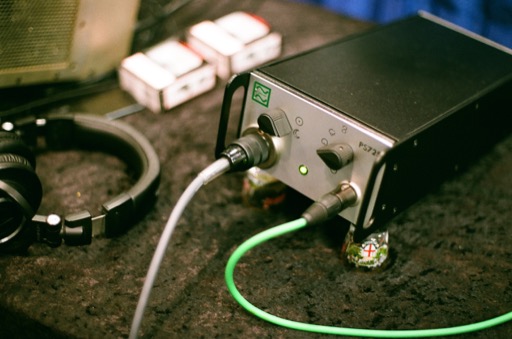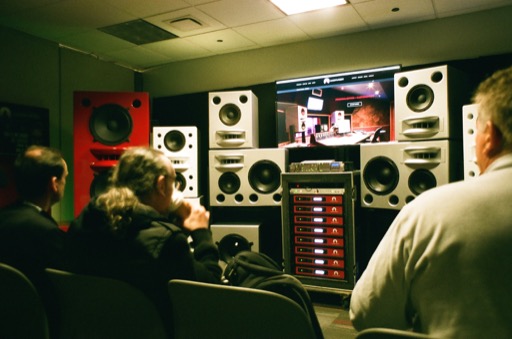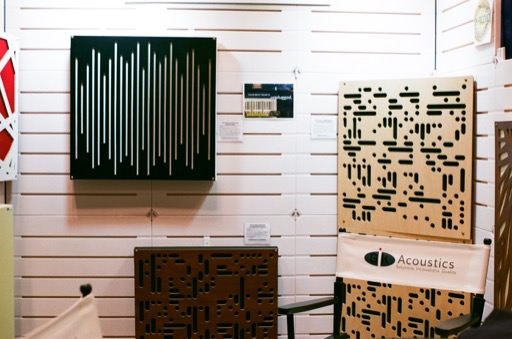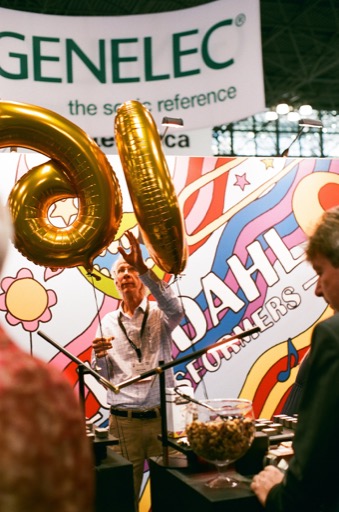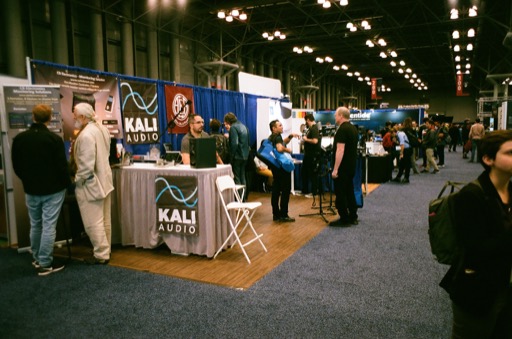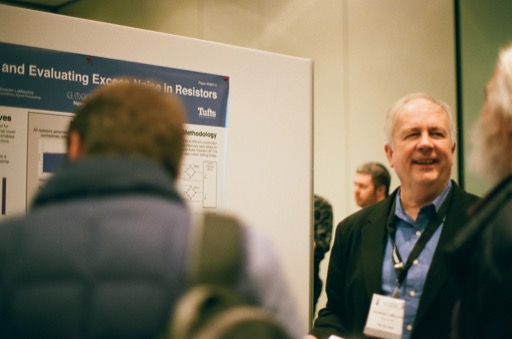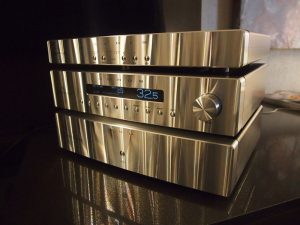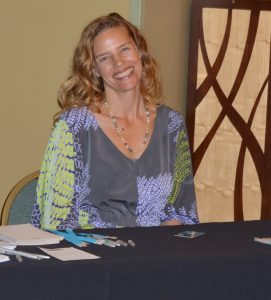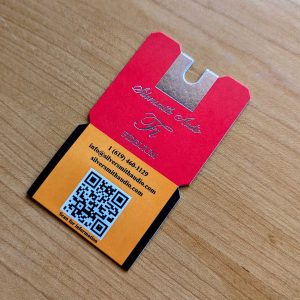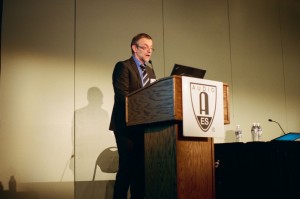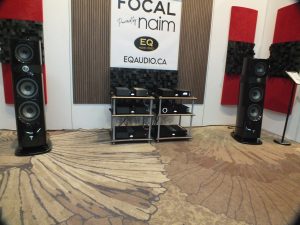"Well, you can take a crosstown bus if it's cold or if it's raining,
And the animals will love it if you do."
- The Zoo, Simon and Garfunkel
The Audio Engineering Society convention is a strange two-lobed thing with a scientific conference downstairs and a trade show upstairs. In the past few years they have been sharing a venue with the National Association of Broadcasters show in an effort to keep costs down. They allow AES attendees entrance to the NAB show which makes for a third thing for the attendee to see. So there's a lot there. Every year I try and look at the show from a high end audio production perspective, because the AES is the place where the higher grade and bespoke audio production gear is often shown. Here's what I saw and what I thought was interesting.
Microphones
Probably the most interesting thing at the show was the Josephson C725 studio microphone. A lot of people like tube microphones on vocals that provide a little bit of nonlinearity on peaks and give a little crunch that makes vocals more forward and stand out in a mix. Some people don't like that at all, they want tube microphones that have solid clean headroom, especially people recording brass instruments. People who want both wound up carrying around two kinds of tube microphone with them. The C725 is an interesting attempt to get these two rather disparate tube sounds out of the same package. It has a cascode stage with a FET and a tube which allows the tube dynamic characteristics to be controlled by the user with a switch. Very cool little device and probably the first advance in tube microphones in fifty years.
Another interesting thing is that Neumann, who twenty years back introduced the TLM103 as a lower-cost alternative to their large diaphragm condenser microphones, has introduced another lower-cost microphone the TLM102, very compact and very quiet.
AEA, the ribbon mike experts, have introduced a cardioid ribbon mike called the KU5A which is vaguely derived from the RCA BK-5 design. As a BK-5 fan, I am very curious to give it a listen.
Measurement microphones are conceptually rather different than the microphones used for recording, and they have some very different requirements. PCB Piezotronics has made IEC Type I measurement microphones for decades, but now they are introducing a mode,l the EX378B02, which is approved for use in explosive atmospheres and other hazardous locations. We usually think of measurement mikes as being used in the laboratory for testing loudspeakers and so forth, but now you can use them in mines and grain silos.
The folks at MicW in China manufacture some reasonably-priced recording microphones based on measurement capsule designs, and their distributor, Full Scale AV, was there showing off some of that line.
Schoeps, one of the old line manufacturers of high grade microphones for classical recording, was showing a new surround miking array. They had a stereo bar with four microphones, two in a standard ORTF configuration and two pointed toward the rear for discrete surround channels. Then they put the whole arrangement into a big fuzzy wind shield. The "ORTF Surround Set" is a rather ingenious arrangement for field recording with everything pre-set and provided as a package that has been tested all together.
Not to be outdone in the surround microphone array world, the folks at Microtech-Gefell, another one of the old line manufacturers that has long specialized in high end handmade microphones, introduced a 9.1 microphone array arrangement using their M221 and M102 microphones combined with one of two mechanical beam support networks to hold them in place. These kits are sold under the tongue-twisting name "Mikrofonanordnungen 9.1-3D Audio."
The folks from Microtech-Gefell also brought with them representatives from Schulze-Brakel, another small company in Germany and one engaged in making very cool microphone windscreens in a variety of shapes and sizes, with custom silkscreened printing designed to be as acoustically transparent as possible. Definitely something new and interesting and very colorful.
Also there were some stand vendors. TAMA was showing off stage microphone stands that were actually well-made, more or less like the quality of stage stands that we expected in the seventies and eighties but which has become rare today. Latch Lake was showing larger stands for studio use, again something that used to be common but which is now a rare bird.
Down below in the papers sessions there were two papers on shotgun microphones. The first one, and what I think is probably the most significant work to come out of this year's conference, was A stepped acoustic transmission line model of interference tubes for microphones by Francesco Bigoni and others. Sadly I wasn't able to attend the presentation because it was scheduled against another item, but I talked with one of the authors and read the preprint and the more I thought the more I realized this was a big deal. The old traditional model of the shotgun microphone that came out of RCA was that of a tube with various entrances, all of which accepted sound, and sound coming on-axis arrived through all the entrances to arrive at the same time at the capsule, while sounds coming through other direction arrived at different times and were therefore attenuated. Unfortunately this model doesn't explain some of the features of the microphone pattern. Around 2010, Ono and Sasaki proposed a more sophisticated model which took into account the attenuation of signals as they progressed down the tube and this allowed better prediction of microphone pattern. Mr. Bigoni proposes an update to this describing the tube as a sequence of little tubes, each a lossy transmission line, so the fact that the conductance of the pipe changes in discrete steps can be taken into account. This appears to give good correlation with real-world measurements, and is the first time anyone has successfully modelled short interference tubes with any degree of accuracy. The author has a habit of repeatedly referring to an unpublished degree project throughout the text and we hope perhaps this will encourage him to publish this work as well. AES Paper 10094.
Mr Sasaki, one of the developers of earlier models, spoke himself on a Shotgun microphone with high directivity by extra-long acoustic tube and digital noise reduction. He described a long shotgun with an added rear microphone array to allow software cancellation of the rear lobe. This doesn't seem like a huge technological advancement but it was a good discussion about how the device was engineered. Paper 10097.
In Microphone Comparison for Snare Drum Recording, Matthew Cheshire and others from Birmingham City University in the UK did a listening test where people with audio production experience evaluated isolated recordings of snare drums made with a variety of different microphones, and then did the same task with the kick and high-hat also being played. Preferences were different when leakage from other drums was involved. I'm not sure how useful this is as a guide to microphones because the character of the snare spot changes so much when it's brought in with overhead microphones, but it's a look at what attributes people seem to prefer in a snare microphone. AES Paper 10040.
Wireless
Everyone is doing wireless microphone systems! Lectrosonics, long known for high-end UHF and VHF wireless gear, was showing off digital systems using the 900 MHz ISM band. Although the ISM band is cluttered in many places, it's at least free from television interference and as the TV band is being chopped up and sold off in the US, more and more wireless users are being driven out. Their D4 systems don't have a lot of channels on the 900 Mhz band, but they have considerable range. Taking a totally different tack to the same problems, the folks at Alteros, a company recently formed by Audio-Technica, were showing off a wireless system using spread-spectrum over the 6 GHz band. Because it's spread so wide, they are able to use shared frequencies rather than be driven into an ISM band. However, the high attenuation and high directivity of the 6 GHz band means very short range and the need for multiple receivers on stage. This is a huge win for applications in crowded cities where many tens of different frequencies are needed on a single stage. The short range reduces interference, even between adjacent stages in the same facility, and makes for higher reliability in permanent installs.
Speakers
Anyone interested in the classic horn speaker sound should check out the Augspurger studio monitors. These folks have traditionally made large maple-horn 2-way monitors for soffit mounting in larger control rooms, but as studios have become smaller, they have been introducing some smaller horn systems that are still very bright, very forward, still able to play at insanely high levels and with that traditional horn sound, but in smaller packages. I heard their Solo 12 system and thought it would be very much at home in a high end system with someone who liked that horn sound.
ATC was showing their compact active monitors, the SCM25A pro. These are very British-sounding speakers, but as needed for a studio monitor they are also very rugged and can withstand loud sounds from mispatched cables and other studio accidents. They had a few larger and smaller systems, but the three-way SCM25A is hard to beat if you like that traditional recessed British sound like I do.
Hedd Acoustics had some smaller monitors using Heil-style tweeters. Hedd is short for "Heinz Electrodynamic Designs" and they are a fairly new company out of Germany. Likewise another German company, ESI Audiotechnik, was selling the Unik 08+ monitor which uses what they described as a "magnetostatic tweeter." I wish I had the opportunity to listen to both of these under better conditions than were available on the show floor.
Another German company, Kii, had a room downstairs where they were doing demonstrations of their new Kii three speaker. This is a two-way system with multiple woofers coordinated through dsp, very forward and bright, but still clean and not spitty, and with surprisingly good imaging in a demo room with terrible acoustics. Their attempt to focus lower frequencies using multiple drivers definitely was a help in a room like that.
Focal had some new monitors too. Their new "Shape Series" of smaller nearfield monitors used flax woofers, passive radiators, and a new tweeter design. Focal was very well known in the high end home world as a driver manufacturer for many years, but these days the only way to get their drivers is to purchase them as part of their complete loudspeaker systems. They are constantly upgrading these systems and this new series replaces their older line of compact monitors. Focal makes a serious attempt to voice everything in each line similarly so if you like the small ones you're likely to like the bigger ones even more.
Amphion from Finland was also showing off a a line of very clean sounding smaller monitors. Again I really wish I could have heard them under better conditions because they are beautifully made.
Oh yes, and this: Auratones. The original manufacturers are back making these tiny full-range speakers, intended as check mix monitors to hear what things sound like on TV sets, but which a lot of people have liked for judging midrange balance. Very very far from hi-fi but still interesting and useful because sometimes hi-fi isn't the point.
There were a huge number of papers about speakers, and I only attended a couple of them, but I was glad I did. We think of a speaker port as being a lossy delay line.... sound goes in one end and less sound comes out the other end after a certain time. The problem is that air is compressible and at high levels or with long delays, the delay and loss change with level. In Characterization of nonlinear port parameters in loudspeaker modelling, Doug Button and others described a practical way to model this effect and work a nonlinear function into the familiar thiele-small loudspeaker model. AES Paper 10062.
Danii Sinev spoke on Low-complexity non-linear loudspeaker protection. When amplifiers are integrated with loudspeakers, it's possible to do additional processing before the amplifier to provide speaker protection rather than have to put protection devices between the amp and speaker. The author describes a simple method of doing this. He doesn't address specific mechanisms of speaker failure individually but attempts to treat them all with a single level-dependent filter. This is an interesting approach that requires little computational power. AES e-Brief 480
Acoustics
There were a lot of new companies selling acoustical products. EZ Acoustics Pro out of Spain now has a US division in Florida, with a complete line of products for absorption, diffusion, and structure isolation.
Plenty of old favorites were still there too. Acoustics First from Richmond Virginia was showing all manner of useful treatment products as well, including some very inexpensive banner products for controlling large rooms and some very fine diffusion panels.
GIK Acoustics was showing a complete line of products but most notably they had some beautiful-looking diffusion panels and wood-framed bass traps. Jocavi from Spain was showing a full line but what I found interesting is that they still had cork panels. Cork was once a very popular acoustic treatment, and although it's fallen into disuse, the appearance and smell still make it a great choice in many places. So many different companies were making these products with similar performance but different appearance so you could pick something to fit in with your decor.
PSI Audio is a Swiss company that has long been known for clean sounding studio monitors voiced for use at reasonable levels. They are now selling the AVAA C20, an active bass trap which is a box with a speaker driver, a microphone, and feedback electronics that keep the air pressure around the speaker constant in order to provide more effective bass control while using up less space. This is a huge deal for controlling smaller rooms like today's control rooms but would also have a whole lot of application in any living room or playback facility.
Soundproof Windows, Inc. was showing off... well.. soundproof windows and doors. Very fine and solid for any listening room or studio installation.
On a very different but related note, Isoacoustics was showing off a line of isolation products for studio monitors, guitar amps, subwoofers and so forth. Their Iso-Pucks are large enough they can even be used under microphone stands. Avoiding structure-borne vibration means tighter and more controlled bass, less annoyance to other people in the building, and in studios it can help reduce annoying effects like the snare rattling when the bass guitar plays. Useful problem solvers for home and studio indeed.
A company out of China called SineMedia was selling their "Acoustic Phase Calibrator Processor" which appeared to be a low latency automatic room correction device. They attempted to correct for both room phase and frequency response, which of course is only effective at one point in the room and isn't generally that useful a concept. Still, it was interesting to see inside their processing platform which was rather nicely designed around FIR filters implemented in FPGAs. The hardware was nicely built and could likely be repurposed for something more effective.
In Reproducing Low Frequency Spaciousness and Envelopment in Listening Rooms, David Griesinger makes some important points about low frequency imaging being very important to the perception of envelopment, and about how many rooms and speaker systems are not designed to allow this. He makes some basic comments about the basic requirements in a room to get imaging at low frequencies and what is required to test for it. No new research but a good set of useful observations that are right on the mark about an increasingly neglected aspect of sound reproduction. AES Paper 10063.
Sound Field Recording
Stereophony being a rather makeshift sort of way to achieve imaging, with the transfer function of the record and playback rooms superimposed on one another and the sound reproduced only at two points, in a perfect world we would want to reproduce the entire front of the waveform in 2-dimensional space across the room. Many folks have discussed doing this via holographic methods, reproducing an interference pattern with a huge array of many speakers, but there are some problems with this approach and a lot of work has been done on determining workable arrays. In Microphone Array Geometry for Two Dimensional Broadband Sound Field Recording, Wei-Hsiang Liao and others from Sony in Japan discussed an array made with omnidirectional microphones and a mathematical representation of the recreated wavefront. Paper 10082.
Headphones
Lots of new headphones at the show but the ones which I think would be of most interest to PF listeners are the new RAAL/Requisite ribbon headphones. Very bright and detailed, possibly to a fault, but very open and a new ribbon technology that is worth checking out.
Warwick Acoustics was also showing off headphones with a new electrostatic transducer, their HPEL "High-Precision Electrostatic Laminate." Again very very bright sounding but it was hard to tell more than that on the show floor with open-ear phones.
Down in the papers sessions, Andreas Maennchen and others from the Fraunhofer Institute spoke on an In-ear headphone system with piezoelectric MEMS driver. These people fabricated a headphone driver by electrostatic deposition on the surface of a silicon chip, making four actuators out of a piezoelectric material that could be evaporated and deposited onto the surface on top of a silicon support structure created by etching. The method lends itself to inexpensive mass production but results in a very underdamped system with some curious resonances. The actuators themselves form the diaphragm and inherently don't move like a drumhead, so modelling this is an interesting task. I don't know if this is the future of in-ear designs but it's the beginning of something very new. AES e-Brief 469.
Loudaholism
In Hyper-compression in Music Production: Testing the "Louder is Better" Paradigm, Robert W. Taylor set about testing one of the fundamental issues behind the current plague of overcompressed audio. He did two tests, one with listeners given compressed and limited audio vs. original audio, normalized to maximum digital levels, and another one where the same samples were presented normalized to identical perceived loudness. Confirming all suspicions, he found that there were no general preferences regarding dynamic processing on a short listening task when normalized to perceived loudness but there was a considerable one when normalized to maximum peak level. This verifies much of the arguments regarding the nature of the loudness war. Paper 10065.
Other serious loudness issues are caused by leakage of low frequencies from outdoor concerts. In Sound field control for reduction of noise from outdoor concerts, Franz Heuchel and others from the TU Denmark evaluate a phased array of subwoofers designed to produce even bass in area while cancelling out as much bass once you get outside of the concert area. It tests well under real-world conditions and does not look to be difficult to implement in concert settings. The results they show are usefully better than those of conventional three-subwoofer cardioid arrays which are currently the most common method of bass control. AES Paper 10107.
It's hard enough to tell which of two samples is louder and by how much, since our perception is not a simple linear mechanism. Much of the time, though, we want to enforce limits, either legally or in other ways, based on how annoying a sound is. Cars with nuclear subwoofers leaking out loud thumping sounds are very annoying when the A-weighed SPL measurement nearby is below the noise floor, but a continuous rumble at the same frequency and level is not as annoying. What makes a sound annoying and how do we measure it? The AES has set up a standards committee on annoyance to answer just this question and their first meeting was at this show. It consisted mostly of a discussion about what the nature of the problem really was, and it was fascinating to see people from very diverse backgrounds and fields coming together to discuss this subject. Look for more from this in the future.
Birthdays
Dan Dugan was celebrating his 50th year in the audio industry and had a small party with cake for bystanders. Dan has long made ingenious gadgets for the audio-for-video production industry, most notably automatic mixers that make working talk shows far easier.
At the same time, Lundahl was celebrating 90 years of manufacturing audio transformers. Their small facility in Sweden has long been known for manufacturing a wide variety of different transformers for audio applications from microphone input to tube amplifier output.
Processing
Benchmark has long been known in the high end world for their converters and power amplifiers. They were showing their DAC3B, which is a stripped down and minimialized version of their standard DAC3 D/A converter. No volume control, no muting, no headphone amp, so there's little to affect the sound after the A/D itself. Although intended for studio monitoring applications it would be a great home converter when paired with a line amp.
DW Fearn has long sold some excellent audio processing gear, from mike preamps and equalizers down to compressors and limiters. He's gone in now with Hazelrigg Industries which is making a complete channel strip, with a preamp and equalizer, using amplification and power supplies designed by Mr. Fearn combined with Hazelrigg equalization electronics and switching. Very nice looking and likely the same good sound people have come to expect from Fearn.
Lossy Compression
Perceptual encoding, much as we dislike it, has become a fact of life and we need to make the best of it. This is hard if we can't really tell what audible effects it's having on music. In On the Influence of Cultural Differences on the Perception of Audio Coding Artifacts in Music, Sascha Dick and others presented some recordings with varying common coding artifacts to listeners in both China and Germany. They didn't specify the material, only that it included both Western music and some Beijing Opera recordings. What was interesting was that German listeners were much more sensitive to spectral holes (frequency bands that disappear completely in encoding) while Chinese listeners were more sensitive to disruption of pitch in harmonics. Musicians tended to be less annoyed by low-pass filtering than by tonality mismatch compared with non-musicians. Some of the differences might be accounted for by the nature of a tonal vs. a non-tonal language. This is very far from complete and there is information missing here, but this is a big step toward pointing out the existence of listener differences in artifact audibility. AES Paper 10030.
Tubes
Charles Whitener Jr. has the tooling from Western Electric and the trademark and the ability to make genuine Western Electric 300B tubes, which he is gearing up a factory in Georgia to do. This is one of the more exciting things at the show for anyone interested in tubes, because although everyone and his brother is making a 300B clone, he is making the real thing.
I found myself on a panel with Dan Kennedy and David Hill, talking about Vacuum Tube Electronics for Solid State Engineers. I think we managed to make a good overview about the design philosophy for older vacuum tube gear that explains why some decisions were made that may seem alien to younger designers today.
Another panel, Design and Build Your Own Gear, had Bob Katz talking about a simple tube processing device that he constructed using a nuvistor stage that could be bypassed to add an adjustable and calibrated degree of nonlinearity to a mastering chain.
Cable
Belden wasn't there at all for the first time in many years! There was a Belden booth at the adjacent NAB show, but they didn't have any cable there and nobody that knew cables. With the retirement of the long-standing broadcast rep Steve Lampen, it's disturbing to think Belden may not be keeping a presence at the show in the future.
Asahi Kasei was showing off a cable called "Roboden" which was a tiny variant on old-style coiled phone cords, except that there was a solid elastic rod going down the center. This creates a cable that can be stretched like a bungee cord. Because the conductors are coiled, the capacitance is high and varies with extension, but they say they can make it shielded and the general idea is kind of ingenious.
Components
Very few component vendors this year. Neutrik had their usual connector line, and Susumu, a Japanese vendor, was selling very low noise thin film resistors intended for high-end applications. With both tubes and transistors, plate, collector, and drain resistors all can produce substantial excess noise in very high gain circuits and Susumu's new series is designed to reduce that. Unfortunately their lowest noise parts are available only in surface mount packages but they make some very fine through-hole parts as well.
Brewster LaMaccia and Bradford Swanson had a very relevant paper, Measuring and Evaluating Excess Noise in Resistors. They had an interesting bridge circuit that allowed them to separate the thermal noise (which is inherent in all resistors and independent of current) from the flicker noise (which has a different spectrum and is dependent on current). Very much worth checking out for anyone interested in evaluating resistors for audio circuits. Not innovative, but a good overview and a good summary of testing methodology. AES E-Brief 486.
By far the most exciting components from the perspective of the high end world is that Lundahl Transformers has added three new MC step-up transformers to their line. One of them is very specifically designed to be designed into a preamplifier that provides a specific unusual load, but the other two are different ratio versions of their existing transformers which can readily be used externally with 47k inputs. Anyone who is a fan of moving coil cartridges for vinyl playback should welcome this.
Sowter wasn't there but Brian Sowter was at the show, and he manufactures a huge line of very high quality transformers with vintage designs, including excellent replicas of many classic types such as the Ampex 350 input and output transformers. Great for new designs and equipment repair. Mr. Sowter and I never met up and just kept leaving messages and cards for one another, which sadly is part of the nature of the show.
Port-Hamiltonian models allow you to develop a mathematical representation of an analogue circuit for simulation. But, if your original circuit has, for example, paralleled capacitors, you can't make a direct representation, but you have to use simple circuit theory in order to create an equivalent circuit with a single capacitance. In Analog circuits and Port-Hamiltonian realizability issue: a resolution method for simulations via equivalent components, Judy Najnudel and others at IRCAM do exactly that. AES Paper 10053.
Tape
Mara Machines was selling an MCI JH-110 broadcast recorder for $5k which seemed a bit steep, but it was beautifully restored. They also appeared to have some replacement parts and repair services for the JH-110 and JH-24 recorders.
Nagra was showing off a great line of digital recorders but they ALSO still have brand new analogue recorders available, as well as US support for older analogue recorders.
Jen-Luc Renou from Mulann was there at the show although not exhibiting. Mulann is the company which owns all the intellectual property and what is left of the manufacturing facilities from Pyral, BASF, RMGI, and Agfa tape, and they are still continuing to make high quality analogue tape formulations including the classic Agfa PEM 468.
Thomas Mitchell and Christopher Bennett had a poster on Characterizing the effect on linear and harmonic distortions of AC bias and input levels when recording to analog tape. These folks did exponential sine sweeps of a Scully 280 tape machine with the pre-distortion disabled, to analyze frequency response and harmonic distortion. This doesn't completely characterize system nonlinearities, but it allows you to see how the distortion spectrum and response change with bias. This is not new information, but it's presented well with accurate spectra and it's done with a rather peculiar tape machine which also makes it interesting. Worth checking out for anyone interested in analysis of tape technology. Paper 10039
Non-Tape
Sound Devices has made a line of high quality field recorders much beloved in the film industry, and they have now come out with a lower cost and smaller line, the Mix-Pre series. Their Mix-Pre 10M has eight microphone inputs, a small screen and small knobs, but sells for well under $2k and they claim the microphone preamps and converters are actually better than their previous more expensive generation of recorders.
Magazines
The folks from Tape Op were there! If you don't know Tape Op, it's a magazine that concentrates on audio production, has a whole lot of actual substance (if some silliness) and is free. If you're at all interested in day to day production work they are worth subscribing to.
The folks from Resolution weren't there! Resolution is another great magazine for production work, published out of the UK. They had a booth there at the show... but it was empty and nobody was staffing it. It's a shame since I wanted to speak with them about a number of things.
Sound-on-Sound, another British magazine was there, as were the folks from Recording Magazine out of Boulder, Colorado. AudioXPress was there too.
Misc
What I like about the AES show is that sometimes people come out with the most off-the-the wall things that make you think about audio in ways you didn't before. In Why can you hear a difference between pouring hot and cold water? An investigation of temperature dependence in psychoacoustics, He Peng and Joshua D. Reiss present some previous studies that show that it's possible for listeners to tell if a recording of pouring water was done with hot or cold water. They then investigate the different sources of sound when water is poured and how each of them are affected by temperature. This doesn't answer the actual question, but it provides a step toward answering the question. It's a question I would never have thought to ask either, but one that helps show just how amazing human hearing is. AES Convention e-Brief 473.
The Mix With the Masters program had a booth which seemed mostly distinguished by extremely high sound levels. It was impossible to go anywhere near without earplugs.
A company called My Studio Sessions had a very ingenious online scheduling package for studios. Potential customers could find a studio in their area with particular services available, but the company also handled all studio booking for you. Having worked at big studios where there was a full time "traffic manager" who did nothing but handle this sort of work, it's good to see modern technology making similar services available to smaller studios at a reasonable price.
Over on the NAB side, Hedbox was showing a line of rechargeable batteries, universal lithium chargers, and adapter plates for a variety of cine, video, and portable audio equipment. I was shocked at how reasonably-priced it was.
Also on the NAB side there was a company selling optics with the ingenious new name of "Zreiss." Sheesh, how bad can it get?
The China Entertainment Technology Association had a booth, but just like Resolution, nobody ever showed up to man it. What is the story behind this?
And there was what promised to be a very cool talk about the film Both Sides Now: Joni Mitchell at the Isle of Wight. The film was shot in 1970 but due to synchronization and budget issues was only recently finished, and the post production was done all in a modern digital system using the original film materials. Unfortunately nobody could tell me where to get tickets... the program book said they were at registration, the website said they were available at the Dolby booth. Nobody at the Dolby booth knew where they were and they sent me to registration, who sent me back to the Dolby booth. Apparently some people did manage to find tickets somewhere but throughout the event people keep trickling into the Dolby booth asking for them.
Ward-Beck, a Canadian company that has been in the broadcast world for many decades, is now very heavily into the AES67 digital distribution world. They were showing off a huge variety of AES67 devices, all of which will integrate well with Dante as well as other digital network formats that are AES67 compatible.
Conclusion
I can't claim to have seen more than a tiny fraction of the whole AES show, and I probably missed a lot of things that the PF readership would find interesting. This is only a very short list of things that I saw and liked, and I urge you to visit New York next fall and get a view of what is there for yourself.





